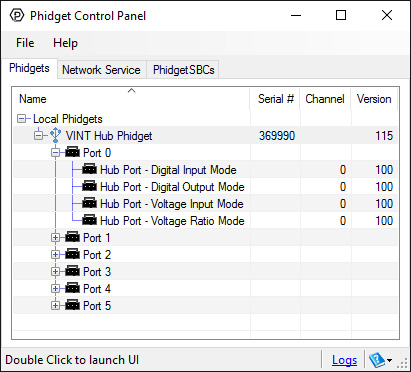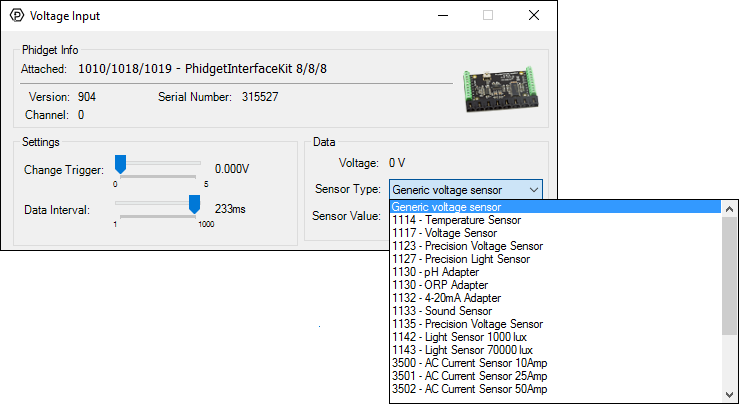
Quantity Available: 1000+
| Qty | Price |
|---|---|
| 10 | $18.05 |
| 25 | $16.15 |
| 50 | $14.25 |
| 100 | $13.30 |

The Voltage Sensor measures the differential voltage between the input terminals. The maximum differential voltage that can be measured is ±30V.
Welcome to the 1132 user guide! In order to get started, make sure you have the following hardware on hand:
Next, you will need to connect the pieces:

Now that you have everything together, let's start using the 1135!
In order to demonstrate the functionality of the 1135, we will connect it to the HUB0000, and then run an example using the Phidget Control Panel on a Windows machine.
The Phidget Control Panel is available for use on both macOS and Windows machines. If you would like to follow along, first take a look at the getting started guide for your operating system:
Linux users can follow the getting started with Linux guide and continue reading here for more information about the 1135.
After plugging in the 1135 into the HUB0000, and the HUB0000 into your computer, open the Phidget Control Panel. You will see something like this:

The Phidget Control Panel will list all connected Phidgets and associated objects, as well as the following information:
The Phidget Control Panel can also be used to test your device. Double-clicking on an object will open an example.
Double-click on a Voltage Input object in order to run the example:

General information about the selected object will be displayed at the top of the window. You can also experiment with the following functionality:
The 1135 measures the differential voltage between the input terminals and outputs the difference proportionally. The maximum differential voltage that can be measured accurately is ±30V. When the positive and negative inputs are equal, the voltage output value is 2.5V. When the positive input is 30V greater than the negative input, the voltage output is 4.5V and when the positive input is 30V less than the negative input, the voltage output is 0.5V.
When measuring voltage levels below 5V, you'll have more accuracy if you connect the leads directly to the voltage input of the HUB0000 (or compatible product).
Since the 1135 can measure a differential voltage, the common mode rejection (CMR) is an important specification. CMR refers to the amount of voltage that both input terminals of a differential amplifier can be offset without affecting the output gain. For example, if the positive terminal sees a voltage of 7V and the negative terminal sees a voltage of 5V, then the CMR would be 5V and would output a value of 2V at unity gain. For the 1135, it is able to measure the differential voltage of ±10V with a CMR of 40V while keeping the accuracy within 2%. Please note that the error specifications do not include the error introduced by the Analog to Digital Conversion on the Analog Input. (if you are using the 1135 with a PhidgetInterfaceKit) The majority of error introduced by the Analog to Digital conversion is from the error in the voltage reference (0.5% max), and the limitation of resolution in the analog-to-digital converter. The best accuracy can be achieved by using a 2 or more point calibration of your system - effectively calibrating the 1135 and the PhidgetInterfaceKit in a single step. If you are calibrating, be sure to use a good quality multimeter to determine the voltage being applied.
The Phidget libraries can automatically convert sensor voltage into differential voltage (V) by selecting the appropriate SensorType. See the Phidget22 API for more details. The Formula to translate the analog voltage returned by the 1135 into differential voltage is:
where Vdiff is defined as Vpositive - Vnegative, and Vsens is the voltage returned by the 1135. For maximum accuracy, measure the sensor voltage when measuring a 0V source and replace the "2.5" in this equation with the zero value that you've measured.

The Phidget Cable is a 3-pin, 0.100 inch pitch locking connector. Pictured here is a plug with the connections labelled. The connectors are commonly available - refer to the Analog Input Primer for manufacturer part numbers.
| Sensor Properties | |
|---|---|
| Sensor Type | Voltage (DC) |
| Controlled By | Voltage Input (0-5V) |
| Sensor Output Type | Non-Ratiometric |
| Voltage Sensor | |
| Voltage Difference Max | ± 30 V DC |
| Relative Input Voltage Max | ± 40 V DC |
| Measurement Error Max | 0.5 % |
| Sensor Response Time Max | 10 ms |
| Voltage Offset Max | ± 100 mV DC |
| Electrical Properties | |
| Supply Voltage | 5 V DC |
| Current Consumption Max | 3.6 mA |
| Sensor Input Impedance | 1 MΩ |
| Output Voltage Min | 0 V DC |
| Output Voltage Max | 5 V DC |
| Physical Properties | |
| Recommended Wire Size | 16 - 26 AWG |
| Operating Temperature Min | -40 °C |
| Operating Temperature Max | 85 °C |
| Customs Information | |
| Canadian HS Export Code | 8473.30.00 |
| American HTS Import Code | 8473.30.11.80 |
| Country of Origin | CN (China) |
| Date | Board Revision | Device Version | Packaging Revision | Comment |
|---|---|---|---|---|
| March 2010 | 0 | N/A | Product Release | |
| December 2017 | 0 | N/A | B | Removed Phidget cable from packaging |
This device doesn't have an API of its own. It is controlled by opening a VoltageInput channel on the Phidget that it's connected to. For a list of compatible Phidgets with Voltage Inputs, see the Connection & Compatibility tab.
You can find details for the VoltageInput API on the API tab for the Phidget that this sensor connects to.
This sensor can be read by any Phidget with an Analog Input or VINT Hub port. It will connect to either one using a Phidget cable. VINT Hub ports can behave just like Analog Inputs, but have the added flexibility of being able to be used as digital inputs, digital outputs, or ports to communicate with VINT devices. For more information about VINT, see the VINT Overview page.
| Product | Voltage Inputs | ||
|---|---|---|---|
| Part Number | Price | Number of Voltage Inputs | Voltage Input Resolution (bits) |
 VINT Hub Phidget
|
$40.00 | 6 (Shared) | *** 15 bit |
 1-Port VINT Hub Phidget
|
$26.00 | 1 (Shared) | ** 16 bit |
 VINT Hub Phidget
|
$35.00 | 6 (Shared) | * 15 bit |
 Wireless VINT Hub
|
$65.00 | 6 (Shared) | * 16 bit |
 PhidgetSBC4
|
$130.00 | 6 (Shared) | * 16 bit |
 PhidgetInterfaceKit 8/8/8
|
$90.00 | 8 | — |
 PhidgetInterfaceKit 2/2/2
|
$50.00 | 2 | 10 bit |
 8x Voltage Input Phidget
|
$22.00 | 8 | 12 bit |
 PhidgetInterfaceKit 8/8/8
|
$90.00 | 8 | 10 bit |
 PhidgetInterfaceKit 8/8/8 Mini-Format
|
$70.00 | 8 | 10 bit |
 PhidgetInterfaceKit 8/8/8 w/6 Port Hub
|
$110.00 | 8 | 10 bit |
 PhidgetTextLCD 20X2 : White : Integrated PhidgetInterfaceKit 8/8/8
|
$70.00 | 8 | 10 bit |
This sensor requires a Phidget cable to connect it to an InterfaceKit or Hub. You can solder multiple cables together in order to make even longer Phidget cables, but you should be aware of the effects of having long wires in your system. See a full list of Phidget cables below.
| Product | Physical Properties | |
|---|---|---|
| Part Number | Price | Cable Length |
 Phidget Cable 10cm
|
$1.50 | 100 mm |
 Phidget Cable 30cm
|
$1.75 | 300 mm |
 Phidget Cable 60cm
|
$2.00 | 600 mm |
 Phidget Cable 60cm
|
$2.00 | 600 mm |
 Phidget Cable 90cm
|
$2.00 | 900 mm |
 Phidget Cable 120cm
|
$2.25 | 1.2 m |
 Phidget Cable 150cm
|
$2.50 | 1.5 m |
 Phidget Cable 180cm
|
$2.75 | 1.8 m |
 Phidget Cable 350cm
|
$3.00 | 3.5 m |
 Phidget Cable Kit
|
$10.00 | 80 mm |
 Phidget Cable Extension Wire 22AWG
|
$0.75/Meter | — |
You can protect your board from dust and debris by purchasing an enclosure. An enclosure will also prevent unintentional shorts caused by objects touching the pins on the bottom of the board or any terminal screws.
| Product | Physical Properties | |
|---|---|---|
| Part Number | Price | Material |
 Acrylic Enclosure for the 1135
|
$8.00 | Clear Acrylic |
| Product | Board Properties | Voltage Sensor | |||
|---|---|---|---|---|---|
| Part Number | Price | Controlled By | Voltage Difference Max | Measurement Error Max | Sampling Interval Min |
 20-bit (±40V) Voltage Input Phidget
|
$55.00 | VINT | ± 40 V DC | 0.01 % | 100 ms/sample |
 (±40V) Voltage Input Phidget
|
$30.00 | VINT | ± 40 V DC | — | 12 ms/sample |
 (±1V) Voltage Input Phidget
|
$28.00 | VINT | ± 1 V DC | 0.1 % | 40 ms/sample |
 Precision Voltage Sensor
|
$19.00 | — | ± 30 V DC | 0.5 % | — |